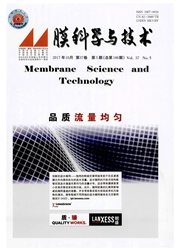

 中文摘要:
中文摘要:
阴离子交换膜有机污染是电渗析用于焦化废水等工业废水脱盐的主要限制因素.本文以废水中常见有机物辛酸为模型污染物,考察污染物质量浓度、pH、电流密度、盐摩尔浓度等对电渗析异相阴离子交换膜污染的影响,表征污染前后离子交换膜的电阻、接触角、离子交换容量等性质变化.结果表明,当溶液中辛酸达到一定质量浓度(约300~400mg/L)时出现阴离子交换膜污染,且随着污染物质量浓度升高而更显著;对比不同pH的影响,发现酸性条件下由于抑制辛酸解离会造成膜污染较为严重,而碱性条件下未观察到明显的膜污染;随着电流密度增大膜污染明显加剧,且该体系中辛酸主要造成异相阴离子交换膜的淡室面发生污染.可通过减小污染物质量浓度、升高pH、控制电流密度等有效减缓阴离子交换膜污染.
 英文摘要:
英文摘要:
Organic fouling of anion exchange membrane is one of the main limiting factors for industrial wastewater desalination by electrodialysis. Octanoic acid, as model foulant, was used to explore the influence of different factors such as organic compound concentration, pH, current density and salt concentration on anion exchange membrane fouling. The properties of heterogeneous anon exchange membrane were characterized by examining the changes of membrane resistance, contact angle, ion exchange capacity before and after fouling. It was found that organic fouling of anion exchange membrane occurred when the concentration of octanoic acid contained in the solution was about 300 ~ 400 mg/L, moreover, more higher concentration of octanoic acid could lead to more serious membrane fouling. It was also found that membrane fouling caused by oetanoic acid was more serious under the acidic condition, but no membrane fouling appeared at the surface of heterogeneous anon exchange membrane under alkaline condition, moreover, the increase of current density resulted in more serious membrane fouling. In the electrodialysis system with octanoic acid, the organic fouling mainly occurred in the diluted side of heterogeneous anion exchange membrane. The results showed that the membrane fouling caused by octanoic acid could be effectively prevented by means of controlling foulant concentration, pH and current density in the electrodialysis system.
 同期刊论文项目
同期刊论文项目
 同项目期刊论文
同项目期刊论文
 期刊信息
期刊信息
